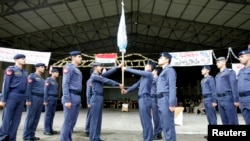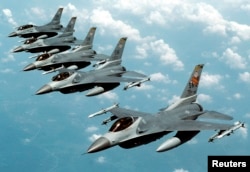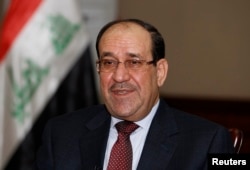President Barack Obama told a recent interviewer he did not want the U.S. military to become Iraq's air force. But he may have little choice.
Iraq had only a fledgling air force when the United States withdrew in 2011. Washington has agreed to bolster Iraqi air power by selling Baghdad 36 sophisticated F-16 multi-role jet fighters and 24 Apache helicopters.
But lengthy contract negotiations, long manufacturing lead times and slow bureaucracies have taken a toll. The Iraqi planes are just beginning to roll off the production line, four years after Congress was first notified of the planned sale and just as Baghdad is fighting for survival against jihadist militants.
As of August, only two of the $65 million Iraqi F-16s had been handed over by Lockheed Martin Corp to the U.S. government and none had reached Iraq. The jets are now held up by payment problems and deteriorating security, which has prevented work needed to prepare Balad air base for the planes.
“The F-16s are not being delivered at this time because the Iraqis did not make the latest installment and because the installation security plan at Balad was not completed because of the security situation in Iraq,” a U.S. defense official said on condition of anonymity.
U.S. strikes this month have helped drive Islamic State back from sensitive Kurdish regions. Islamic State militants beheaded American journalist James Foley in face of the strikes.
The slow delivery of U.S. attack aircraft to Iraq has angered some Iraqi officials and raised questions about whether the Obama administration could have moved more quickly to speed the flow of helicopters and warplanes to Baghdad at a time when it was under increasing threat.
Nuri al-Maliki, who resigned as prime minister last week in the face of widespread criticism over his country's political fragmentation, and other Iraqi officials have criticized the slow delivery of the F-16 aircraft. They blamed the slow-moving U.S. bureaucracy and said Baghdad expected the planes sooner.
Iraqi officials were not available to comment on the planes, as incoming Prime Minister Haider Al-Abadi prepares to form a new government.
Hassan Jihad Ameen, an Iraqi lawmaker on the security and defense committee in the previous parliament, said he thought the United States had been slow to deliver because of concerns Maliki's Shi'ite-led government would use the planes in a way that intensified sectarian divisions with Sunnis.
“Now ... there is a hope that we have this new government which doesn't differentiate between Iraqis and [is] able to create better atmospheres,” Ameen said.
While Iraq is running budget deficits, Ameen said he didn't see the payments issue as a significant barrier.
“Iraq has money and allocations, and the payments will be agreed upon,” he said.
Pentagon officials deny any deliberate slowing-down of the aircraft deliveries. They note the United States has a $15 billion foreign military sales program with Iraq and has worked to accelerate deliveries of equipment where possible.
Bethesda, Maryland-based Lockheed Martin Corp said production of the Iraqi planes will be completed in late 2017. That is months ahead of the time frame projected in the initial contract announcement.
'Washington bureaucracy'
Loren Thompson, an analyst at the Washington-based Lexington Institute think tank who has close ties with Lockheed, noted that “on schedule for the Washington bureaucracy is not the same thing as being timely in the war zone.”
“The U.S. acquisitions bureaucracy is not good at getting things quickly to allies who are under threat,” he said. “Whether it's planes for Afghanistan or planes for Iraq, the system always finds some reason to bog down.”
The kind of air power Iraqis are trying to buy from the United States would be an ideal tool for striking Islamic State militants as they travel in convoys across the country's vast open spaces, said Michael O'Hanlon, a defense analyst at the Brookings Institution think tank in Washington.
“If it becomes an emergency, which it clearly is, then I think there are various ways to get them some limited amounts of air power fairly fast if we decide to make a point of it and go around the usual bureaucratic rules a little bit,” O'Hanlon said.
Almost no air force
Iraq's air force under late dictator Saddam Hussein was one of the mightiest in the region, with about a thousand planes, including Soviet MiGs and French Mirages, according to GlobalSecurity.org. It was badly damaged by the first Gulf War and the sanctions imposed on the Iraq in the late 1990s.
By the time of the U.S. invasion in 2003, the Iraqi air force had between 100 and 300 combat aircraft in service, most of them poorly maintained and eventually scrapped in the aftermath of the conflict.
Today, Baghdad has about a dozen Russian SU-25 warplanes and a half a dozen Russian-made attack helicopters, analysts who study Iraq's military forces estimate.
The remainder is comprised of small- and medium-sized U.S.- and Russian-made helicopters and light, multi-passenger U.S.-made aircraft used for reconnaissance, some of which can launch Hellfire air-to-surface missiles.
“When the U.S. left, it left the Iraqis with almost no air force,” said Ben Barry, a former British army officer who is now a senior fellow at the International Institute for Strategic Studies in London. “That has put them at a considerable disadvantage.”
The United States spent $20 billion to build up an 800,000-strong Iraqi military force and banked on its ability to keep the peace when the U.S. military withdrew in 2011.
That hasn't happened.
Islamic State militants captured U.S.-made military equipment worth millions of dollars from the Iraqi army, which folded in the face of the initial onslaught by the jihadists.
The failure to leave behind a more substantial air force or find ways to help Baghdad rapidly strengthen its force leaves the United States few alternatives to assisting Iraq until Baghdad can secure its own air space, despite administration assertions that use of U.S. air power would be limited.
“We're willing to help and to coordinate a little bit with them, but as the president said, we're not going to become the Iraqi air force,” Rear Admiral John Kirby, the Pentagon press secretary, told reporters.
Militant threats
Building an air force that can control Iraqi air space has been a long-term project. The Pentagon first notified Congress of plans to sell F-16s to Iraq in September 2010, but the contract for the first 18 was not signed until December 2011. The contract for the second 18 came in April 2013.
The first Iraqi plane was flown in May this year and ceremonially presented to the Iraqi ambassador in early June at an event at the Lockheed plant in Fort Worth, Texas.
Even as the initial planes were rolling off the assembly line, Islamic State militants were swarming into northwestern Iraq, pushing close enough to Baghdad to threaten Balad air base, about 50 miles (80 km) north of the city.
Lockheed evacuated about two dozen staff who had been working with the Iraqi air force preparing for the arrival of the jets and helping with training. A second defense official said the decision by Iraq and its contractors to withdraw personnel from Balad meant needed work at the base was not yet complete.
Officials in June were predicting four F-16s could be ferried to Iraq by the end of the year. But the second defense official this month would only say that two of the planes were expected to be delivered to Iraq sometime this autumn.
“I wouldn't want you to think the security situation is the only thing. The security situation is one factor but there are other issues,” the official said on condition of anonymity, noting that “payment has been an issue for some time, even before the security situation became a factor.”
Defense officials said it was still too early even to talk about a delivery date for the Boeing-made Apache attack helicopters.
The Pentagon first notified Congress in January about the planned deal, which calls for Iraq to lease six helicopters temporarily and to purchase 24 others in the coming years.
Steven Bucci, a former Army special forces officer who heads the foreign policy center at the Heritage Foundation think tank in Washington, said the foreign military sales process “is hardly ever fast or efficient.”
“It's generally not a priority unless there is some emergency going on where somebody intervenes and kicks it through the system faster,” he said.













